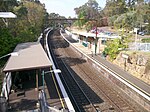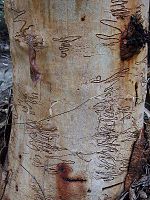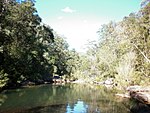Lucasville railway station

The Lucasville railway station is a decommissioned railway station on the Lapstone Zig Zag that closed in 1892. John Lucas purchased land for a country retreat adjacent to the top road of the Lapstone ZigZag. He built his house called Lucasville. The house has disappeared but traces of its gardens and access paths are still visible immediately to the west of the ZigZag walking track.For the convenience of himself, his family, and his guests, Lucas used his political clout to have a railway station built on the Top Road of the ZigZag. Lucasville Station opened in 1877 and the substantial concrete platform, with rock-cut steps leading west into Lucasville grounds. Today the station is part of the Historic Lapstone Zig Zag walking track.
Excerpt from the Wikipedia article Lucasville railway station (License: CC BY-SA 3.0, Authors, Images).Lucasville railway station
Lapstone Zig-Zag Walking Track, Sydney
Geographical coordinates (GPS) Address Nearby Places Show on map
Geographical coordinates (GPS)
| Latitude | Longitude |
|---|---|
| N -33.7611812 ° | E 150.6390519 ° |
Address
Lapstone Zig-Zag Walking Track
2773 Sydney
New South Wales, Australia
Open on Google Maps







